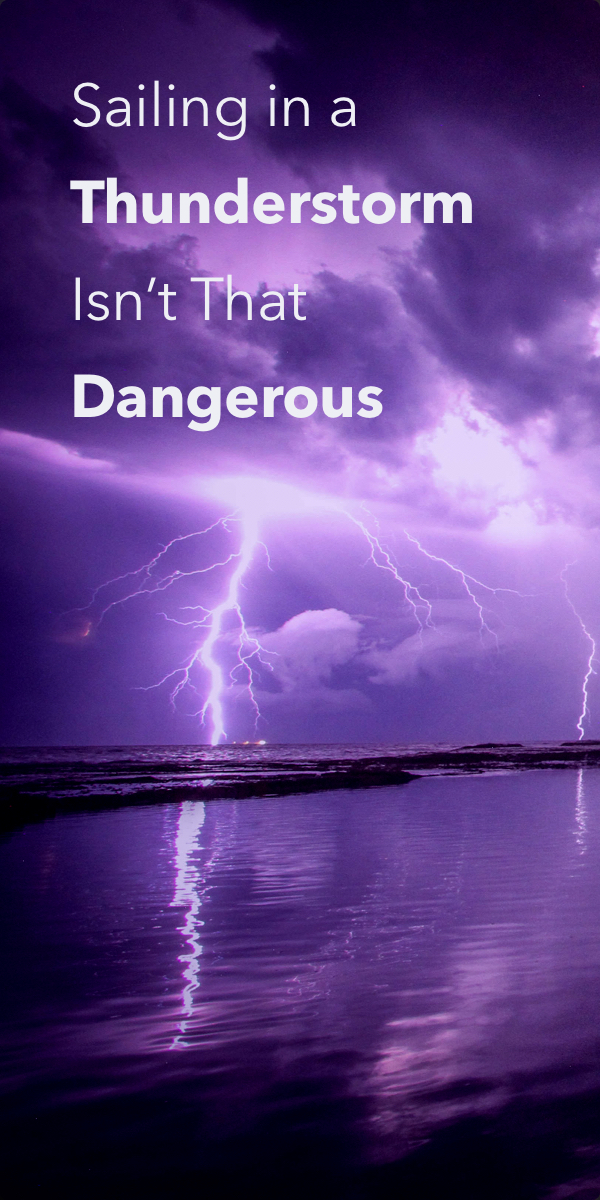Is It Dangerous to Sail in a Thunderstorm?
About 10 years ago I found myself in a major thunderstorm in the middle of a lake with a 20 ft mast and nothing around. But is it dangerous? Let's find out.
Is it dangerous to sail in a thunderstorm? Sailing in a thunderstorm can be dangerous. However, lightning strikes are uncommon. The most dangerous factor in thunderstorms for sailors are unpredictable changes in wind direction and unexpected wind gusts. It is recommended to avoid sailing during storms in general, if at all possible.
There's a lot of myth and legend surrounding electrical storms and sailboat masts. In this article, I'll go over the facts for you. We'll also discuss a couple of solid and easy safety tips for when you find yourself amidst the turmoil.
At the end of the post I'll tell you a cool personal story about my own thunderstorm experience.

Should You Avoid Sailing in Thunderstorms?
The real question, of course, is whether or not you can set sail when thunderstorms have been predicted. The simple answer is: yes, but if you can avoid it, I would.
The more real answer is: it's up to you. But again, I would advise being cautious.
The chances of being hit aren't as great as most people believe (I'll explain below). I've developed a formula that represents the way most people feel about the combination of lightning and sailboats:
Sailboat mast + lightning = A.D.
wherein A.D. stands for assured destruction.
All kidding aside, the biggest danger isn't the lightning, but the unpredictable wind that goes with it.
Most thunderstorms combine with very sudden changes in wind direction and wind speed. In some cases, the wind constantly changes direction 180 degrees. It can cause very powerful gybes, destroying the mainsail or even damaging the mast. And of course, you could get caught off guard, resulting in injury or a man overboard situation.
Do Sailboats Actually Get Hit by Lightning?
Sailboat masts look like they must get hit all the time when in the middle of a lightning storm. But it's not at all obvious that they do. There are a lot of examples where sailors in the middle of a large electrical storm aren't hit at all. At the same time, the water around them gets hit dozens of times. I have experienced the exact same thing myself.
Statistically, you have about a 0.4% chance of being hit when you're on a monohull sailboat. The larger the boat, the more likely you'll attract lightning.
That doesn't sound like a lot, but it's still every 4 in 1000 boats. There are also a lot more startled sailors than lottery winners out there. Still, it's less common than I thought.
Okay, so the lighting itself isn't the major issue. However, IF you get hit, you will experience some real problems, and it can be potentially very dangerous.
If you absolutely need to move your boat, you definitely can. But please make sure you have some experience with heavy weather sailing. Also, have some procedures in place for when the worst case happens.
But personally, if I don't have to go anywhere, I probably wouldn't bother risking it.
Below I'll go into more detail on what happens when a sailboat actually gets hit by lightning, and what you can do to avoid it.
What Happens When a Sailboat Gets Hit by Lightning?
You don't have to panic when there's some lightning around. Impact doesn't usually cause fires, although it can happen.
I want to say right off the bat that every impact is different. The strength of a lightning impact differs every time. But in most cases, the same thing roughly happens. I've heard from one sailor that got struck once that the following happens:
- your rigging may be fried, sometimes destroying it completely
- it will take out all your electronic equipment
- it will take out (part of) your wiring, which may cause a fire
- your batteries will probably explode
- an impact may blow out thru-hull fittings and damage the hull
- there are reports of extensive hull damage
When a lightning strike misses you, but the impact is close by and powerful enough, your electronics could still be taken out.
A full-blown impact may take down your mast, although this is very uncommon. But changes are your rigging gets damaged to the point you can't use your sails anymore. (Which you probably couldn't do anyway because of the wind).
Your electronic equipment will be damaged in some way or another by the peak voltage. Even if you switch them off. Your wiring may be damaged as well, and can even start a fire (although this is uncommon).
Your battery may partially explode. This is one of the more risky things that is actually likely to happen. Exploding batteries are pretty dangerous, and could start a fire.
An impact can also damage your hull and sink your boat by blowing out thru-hull fittings or creating cracks.
What to Do in a Lightning Storm on a Boat?
Turn on the engine - in case your batteries are fried and you can't use your sails. You should turn your engine on to make sure you keep full control over your vessel, even when you lose the mast and batteries. If your batteries get fried, you won't be able to start your engine and are without power. If there are heavy winds and you can't use your sails, you are completely helpless. You will be unable to steer the bow into the wind to avoid capsizing.
Sails down - In case of heavy winds or unpredictable changes, reef down your sails immediately. Don't wait for the heavy weather to really kick in. Acting quickly will save you A LOT of trouble.
Don't hold anything that's made from metal - Once the ship is secured, make sure you don't touch any metal parts for the duration of the storm. This reduces the chance of you getting fried on impact.
Get the fire extinguisher - Fires are uncommon, but make sure you have it at hand.
Stay down below as much as possible - If you're not needed above deck, or if you've decided to sit it out, stay below deck. This will be the safest place in case there's an impact. The hull will act as a sort of Faraday cage (not entirely, but close enough).
Unplug all electronics - Now that you've secured power and control over the boat and yourself, it's time to worry about your gear. Unplug all electronics - I mean physically pull the wiring out of them.
Put small electronics in the oven - I think this is just superstition, but some people say you should put all loose electronics inside the oven to protect them. You probably could give it a try, there's not really anything better to do.
How to Prevent Impacts on Your Boat?
The DIY method: create an easy path for the lightning by taking a piece of anchor chain. Wrap it around the mast, a cap shroud, and then take the end and place it in the water. This creates a kind of earth return, which is said to prevent lightning strikes.
The PRO method: You can install an electrical charge dissipator in the mast head. It looks like a brush. It will avoid the impact to be drawn down by the mast. If you're interested, I found this one on Amazon with great reviews and for a good price.
Quick tip: One of the most likely (and worst) things that can happen after impact, is finding yourself without a means to navigate. Lightning can easily destroy your GPS, and even flip your compass around.
You may consider getting a small backup GPS receiver that runs on batteries. If Store it separately and away from any metal parts. If you're interested, I found this one by Garmin on Amazon with good reviews and for a great price.
You can use it to store waypoints, like the harbor entry and shallows. In my opinion the best backup.
What to Do if You Get Hit?
Let's say you're just unlucky in life - you get hit. What now? How to act?
- immediately check for any fires
- and put them out ASAP
- if you have engine power, try and motor to safer waters
- make sure you retain control over the vessel unless it endangers you
- make sure the bilge is dry and there are no holes in the hull
- if you or a crew member is hit, they could suffer from cardiac arrest - If so, reanimate immediately.
My Experience with Lightning
A friend and I were sailing the IJsselmeer, which used to be the inland sea of The Netherlands. We were almost one week in. It started out as a quiet night. We were at anchor at a peaceful, small lake next to the IJsselmeer. Halfway through our bottle of wine, the boat started rotating around the anchor.
We climbed out of the cabin. We were spinning around at a high speed, and everywhere around us, flashes of lightning came down crashing from the sky. We were the only sailboat on the lake at that time, and it was frightening, to be honest (I was still young). We phoned up a friend, hysterically, and he checked the weather forecast for us. I remember screaming at him, fearing for my life, 'what way does the storm move?!'.
The storm was here to stay for several more hours. We decided to head for safe harbor in the middle of the night. We had no lights. I was the helmsman, my friend stood on the bow, trying to find a safe path in the shallow waters. We navigated by sight best we could. He shouted back directions at me, trying to win the argument from the heavy winds.
In the end, we weren't hit and everything turned out just fine. Man, it was an adventure.
I hope this article will be helpful if you find yourself in such a situation. At the time, I'd really wish there was an article like this out there - luckily we had a helpful and reliable friend on standby.

Did you find the answer to your specific question?
👍 24 👎 1
Comments
Jurriaan Gerretsen
How serious are you in publishing articles like this with a serious mistake.
It states: “Statistically, you have about a 0.4% chance of being hit”. Which is put into context: “That doesn’t sound like a lot, but it’s still every 4 in 100 boats.” In fact 0.4% is 4 in a thousand and not 4 in a hundred. …..
Shawn Buckles
Hi Jurriaan,
Thanks for pointing out the error. I have corrected it. Must have mistyped.
As much as I try to catch all errors, sometimes one slips through.
Thanks again,
Shawn
Philip Mayo
Thank you Shawn!
Very interesting article. Something I had never thought about but it is a little scary to think about. That’s a crazy story story about when you and your freind were caught in a thunderstorm when you were younger. I think I would’ve been freaked out too! Where did you wind up tying up the boat after moving it? Also, did you use the motor (if you had one) to move the boat or the sails?
Ashley
Great article Shawn. Thanks for the tips
Leave a comment